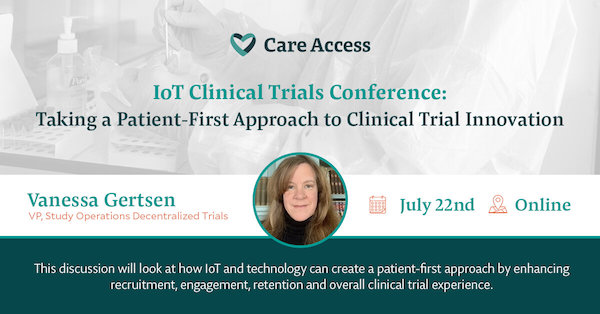Jul 8, 2021
Direct-to-Patient Clinical Research: Care Access Shares Solutions at IoT Clinical Trials Conference

Taking research sites directly to local communities may hold the key to decreasing patient burden. An estimated 70 percent of potential trial participants live over two hours away from the nearest research center, forcing many to think twice about enrolling in a clinical study.¹ Traveling to distant research sites can be time-consuming, costly and, in some cases, nearly impossible for certain patients due to health concerns, work and childcare responsibilities, and lack of access to transportation.
When the 2020 pandemic hit, it became virtually impossible for patients to visit physical research sites, and the clinical trial industry pivoted to online solutions. Virtual tools once considered a “nice-to-have”, such as telemedicine and smartphone apps, became crucial to clinical research continuity, accelerating the adoption of decentralized trials. Hopes were high that these new approaches could reach more diverse and hard-to-reach populations, increase study enrollment numbers and expedite the research process.
But virtual trials could only get the industry so far. While certain activities easily translated to a digital format, more complex procedures still required medical equipment and face-to-face interactions with clinicians. A gastroenterologist could, for example, conduct an initial consult visit via telehealth, but not a colonoscopy. It seemed that certain aspects of clinical trial delivery would always be tied to traditional brick-and-mortar sites, many of which lay out of reach for potential study participants.
In order to bring clinical trials to more people and places, Care Access reimagined the clinical research site. Instead of asking study participants to travel to a research site, why not bring the research site directly to them? The answer was Distributed Patient Enrollment™, a new service where patients could conduct some or all of a trial at a convenient location such as their homes, local clinics and “pop-up” research sites. Such sites can be established anywhere and everywhere, including historically underrepresented communities that have long been overlooked by the clinical trials industry.
Care Access has established a connected network of physicians ready to conduct studies in their local communities as well as a fleet of Mobile Site Vehicles (MSVs) that can be quickly deployed to build “pop-up” satellite sites wherever they are needed. Both community clinics and traveling research teams can conduct complex procedures in person while also leveraging the latest technologies to allow for remote oversight and follow-up with study participants. This combination of conveniently located research sites, home visits and telemedicine, has the potential to reduce logistical barriers to clinical trial delivery and may increase patient enrollment and retention. Taking research directly to local communities offers more opportunities to engage diverse patients and physicians and may ultimately produce more robust and representative data.
Interested in learning more? Vanessa Gertsen, Vice President Study Operations Decentralized Clinical Trials, is speaking on a panel about taking a patient first approach to clinical trial innovation at IoT Clinical Trials: Leveraging IoT & Emerging Technology to Digitally Transform Clinical Trials on July 22, 2021. For more information or to register click here.
References: ¹ Digital R&D. Deloitte Insights. (n.d.). Retrieved June 24 2021, from https://www2.deloitte.com/us/en/insights/industry/life-sciences/digital-research-and-development-clinical-strategy.html